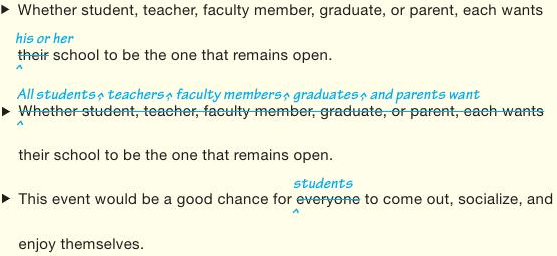G2-a Use pronouns and antecedents that agree in number.
If the antecedent of a pronoun is singular, the pronoun must be singular so that both agree in number. Likewise, if the antecedent is plural, the pronoun must be plural.

When the pronoun and its antecedent do not agree, change one so that both are singular or plural, or rewrite the sentence to eliminate the inconsistency. (See also E2-b.)
Change either the pronoun or its antecedent so that both are singular or plural.

Note: As an alternative, you may be able to eliminate the pronoun.

Revise the sentence to eliminate the inconsistency.

Use a singular pronoun to refer to a singular indefinite pronoun, or reword the sentence.

indefinite pronoun A pronoun that does not refer to a particular person or object. Examples: Singular—anybody, anyone, each, everyone, everything, somebody, something, neither, none, or nobody; Plural—few, many, and several; Singular or plural—all, most, and some.
Consider the level of formality of your writing. Friends in a casual conversation may not mind if an indefinite pronoun and its antecedent do not agree, but such errors are not acceptable in formal writing.
Use a singular pronoun if the antecedent is a collective noun.

Exception: A collective noun may sometimes be considered plural if it refers to the group members as individuals: The couple decided it was time to consolidate their bank accounts.
collective noun A noun (such as class or family) that refers to a group as a unit and is usually considered singular.
(See also G6-b.)